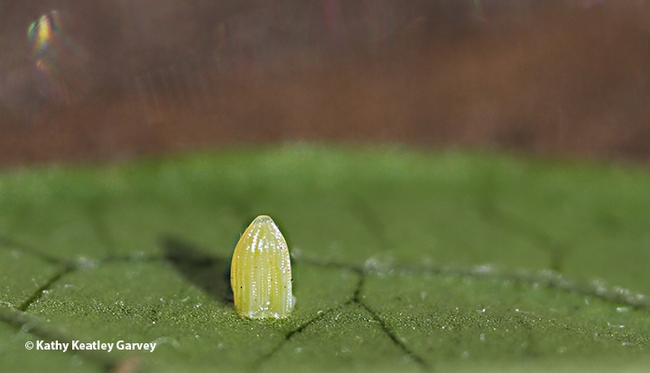
No, say many scientists, including Hugh Dingle, professor emeritus of entomology, behavior and evolution at UC Davis.
Professor Dingle is an internationally known expert on animal migration. He's researched animal migration for some 50 years. In the last 20 years or so, he has focused on monarch butterflies. He has authored two editions of Migration: The Biology of Life on the Move and some 100 papers. National Geographic featured Professor Dingle in its cover story on “Great Migrations” in November 2010. LiveScience interviewed him for its November 2010 piece on “Why Do Animals Migrate?” (See news story that includes his biographical information)
Professor Dingle, a resident of Marin County, responded to a recent front-page article in a Marin County paper about the California ban on tropical milkweed. Banning tropical milkweed, A. curassavica, will NOT save the monarch, Dingle emailed the reporter. In fact, he said, the ban will "essentially have zero effect on monarchs" and "no one should rush out and pull out their tropical milkweed as it would be a waste of time and effort. Nurseries should also be able to continue to sell it."
The professor shared this with Bug Squad:
- "There is not enough tropical milkweed planted to have much influence (see the amount of A. syriaca and A. fascicularis throughout the American West not to mention various other species like A. erosa, cordifolia, californica, etc.) Yes, there are parasites on A. curassavica as there are on ALL milkweeds."
- "There are populations of monarchs that are doing just fine feeding exclusively on A. curassavica (e.g. on many Pacific Islands, such as Guam where I have studied them."
- "Migration and the diapause that accompanies it in the fall are determined by shortening photoperiod and temperature (warm temps can override short days hence the issue with climate change). There is no significant influence of food plant."
Tropical milkweed has been in California for more than a century. It's along our roadsides, in our parks, in our gardens. If the California border were moved a bit, it would be a native plant. Yet the California Department of Food and Agriculture, influenced by native plant proponents, has deemed it a "noxious weed."
Professor Dingle is among many scientists who point out that milkWEED (despite the "weed" in its name), is NOT a noxious plant. If you're standing on the California-Mexico border, on one side it's a noxious weed (evil, dangerous, nasty, get-rid-of-it-now, how-dare-you) and inches away, it's a beautiful host plant for monarchs, and a great nectar source for monarchs and other pollinators, including honey bees, syrphid flies and hummingbirds.
The California Department of Fish and Wildlife's ban on rearing monarchs (no one can do so without a permit) is unsettling to many. Entomologist Jeff Smith, who curates the Lepidoptera collection at the Bohart Museum of Entomology at UC Davis and is a member of the Lepidopterists' Society, reared a few monarchs as a child, but laments that today, no one in California can do so without a permit, and it's difficult to get a permit unless you're a researcher.
In the latest edition of the Lepidopterists' Society newsletter, Robert Michael Pyle (founder of the Xerces Society for Invertebrate Conservation) and David Wagner wrote a piece, "Keep Nets in the Hands of Kids--and Others!"
An excerpt: "Give a kid a net, and watch her go! Not that the net is the only porthole into our world. For some it could be raising caterpillars or tadpoles, keeping mantises and walking sticks as pets, or examining ants, beetles, and grass- hoppers through a magnifying glass. But the common feature is having hands-on, unfettered exploration of the living world as children. Many life-science professionals, including RMP's cardiologist, ascribe their passion for life and nature to hunting bugs, crawdads, and pollywogs in their youth. This is why the Society instituted the Outernet Project, to get nets into the hands of children—a task made more difficult not only by the umbilical USB connection now present at birth and children's subsequent inseparability from electronica, but also by the loss of BioQuip. Is the coup de grâce for children's face-to-face fascination with small-scale life to be delivered now by well-intended but ill-considered regulation?"
So Very Controversial. Amazing that tropical milkweed issue has become so very controversial. You cannot post an image of a egg, caterpillar, chrysalis or a monarch on A. curassavica--a food and nectar source--without a native plant proponent attacking you and ordering you to remove that tropical plant in your garden immediately. (Never mind that you are growing native milkweed as well.) One scientist told me: "They just want to control you and bully you."
In our pollinator garden in Vacaville, monarchs prefer tropical milkweed over the non-natives. Tropical is more toxic.
Mona Miller, who administers the popular Facebook page, Creating Habitat For Butterflies, Moths, & Pollinators, related: "Monarch are resilient insects, they have so many strategies to increase their population, but they do have their limits. We must stop pulling out tropical milkweed and cutting it back. Washing off all milkweed should suffice to clean off the OE spores. I emailed several scientists, no one could tell me that OE (Ophryocystis elektroscirrha is a protozoan parasite) has any way to attach to milkweed leaves other than getting caught in the hairs. Tropical milkweed has smooth leaves. Tropical milkweed has been in California since 1909, that is over 100 years. Totally eradicating tropical milkweed, just like totally eradicating all the eucalyptus trees (non-natives), would have a detrimental effect on the monarch population--perhaps it already has."
Indeed, folks should pay more attention to habitat loss and pesticide use, the real culprits of the monarch population decline.
Bohart Museum Open House. At any rate, be sure to attend the Bohart Museum of Entomology's open house on monarchs from 1 to 4 p.m., Saturday, Nov. 4 in Room 1124 of the Academic Surge Building, 455 Crocker Lane, UC Davis. It's free and family friendly. A number of scientists will be there to answer your questions.
Scheduled to participate are:
- UC Davis distinguished professor emeritus Art Shapiro of the Department of Evolution and Ecology, who has studied butterfly populations in central California since 1972 and maintains a research website, Art's Butterfly World.
- UC Davis emeritus professor Hugh Dingle, a worldwide authority on animal migration, including monarchs. He is the author of Migration: The Biology of Life on the Move (Oxford University Press), a sequel to the first edition published in 1996. See news story on the UC Davis Entomology and Nematology website.
- UC Davis professor Louie Yang, who does research on monarchs. Due to parental duties, he may be able to attend only the last part of the open house. See news story about his work.
- UC Davis professor Elizabeth Crone of the Department of Evolution and Ecology, formerly of Tufts University, who researches monarchs. See news story about the declining monarch population on the UC Davis Entomology and Nematology website.
The Bohart Museum houses a global collection of eight million insect specimens, plus a living insect petting zoo (Madagascar hissing cockroaches and stick insects, among others), and a insect-themed gift shop. UC Davis distinguished professor Lynn Kimsey has directed the Bohart Museum, founded in 1946, since 1990.
Attached Images:
